When insulin binds to t - Study guides, Class notes & Summaries
Looking for the best study guides, study notes and summaries about When insulin binds to t? On this page you'll find 1242 study documents about When insulin binds to t.
Page 3 out of 1.242 results
Sort by
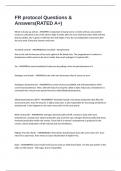
-
FR protocol Questions & Answers(RATED A+)
- Exam (elaborations) • 85 pages • 2024
-
- $15.89
- + learn more
When to bump up actives - ANSWERIt is important to bump every 2 weeks until you see positive results or until client is dry. If the client is flaky 2 weeks after the acne med bumo then hold until the dryness abates. Dry is good. It eikk helo her hesk fadter. If yoy do not seebpositive movement after the acne med, bump the cleanser and toner. Yaz (birth control) - ANSWEREthinyl estradiol + Drospirenone Not on the safe list because of law suits agAinst it for blood clots. The progesterone it c...
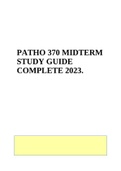
-
PATHO 370 MIDTERM STUDY GUIDE COMPLETE 2023.
- Exam (elaborations) • 63 pages • 2023
- Available in package deal
-
- $15.49
- 1x sold
- + learn more
PATHO 370 MIDTERM STUDY GUIDE COMPLETE 2023. Cytology- the branch of biology surrounding the structure of plant and animal cells Detrimental- tending to cause harm Disseminate- spread widely Diagnosis- the identification of the nature of an illness by examination of symptoms Endemic- a disease or condition regularly found among a particular people in a certain area Epidemic- a disease is disseminated to many individuals at the same time Epidemiology- the study and analysis of the distribut...
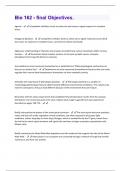
-
Bio 162 Final Objectives Questions and Answers(A+ Solution guide)
- Exam (elaborations) • 36 pages • 2024
-
- $8.29
- + learn more
Agonist - Competitive inhibition, binds to active site and causes a signal response in receptive tissue. Antagonist (blocker) - Competitive inhibitor, binds to active site so signal molecules cannot bind but causes no response in receptive tissue, can bind and release eventually. Apply your understanding of channels and synapses to predict how various neurotoxins affect nervous function. - Neurotoxins block receptor proteins on the post-synaptic neuron. Example: tetrodotoxin form Fugu fish...
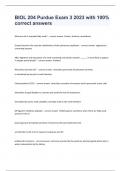
-
BIOL 204 Purdue Exam 3 2023 with 100% correct answers
- Exam (elaborations) • 19 pages • 2023
-
- $16.49
- + learn more
What are the 3 essential fatty acids? - correct answer linoleic, linolenic, arachidonic Enzyme found in the vascular endothelium of the pulmonary capillaries - correct answer angiotensin converting enzyme After digestion and absorption of a meal containing only Grade I protein ______ is most likely to appear in hepatic portal blood? - correct answer histidine What Does Secretin do? - correct answer stimulates pancreatic bicarbonate secretion is stimulated by low pH in small int...
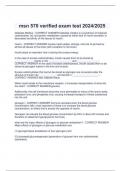
-
msn 570 verified exam test 2024/2025
- Exam (elaborations) • 84 pages • 2024
- Available in package deal
-
- $17.99
- + learn more
msn 570 verified exam test 2024/2025 Diabetes Mellitus - CORRECT ANSWER-Diabetes mellitus is a syndrome of impaired carbohydrate, fat, and protein metabolism caused by either lack of insulin secretion or decreased sensitivity of the tissues to insulin. insulin - CORRECT ANSWER-causes rapid uptake, storage, and use of glucose by almost all tissues of the body (with exception to the brain). Insulin plays an important role in storing the excess energy. In the case of excess carbohydrates...
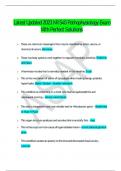
-
Latest Updated 2023 NR 545 Pathophysiology Exam With Perfect Solutions
- Exam (elaborations) • 34 pages • 2023
-
Available in package deal
-
- $25.19
- + learn more
Latest Updated 2023 NR 545 Pathophysiology Exam With Perfect Solutions A. These are chemical messengers that may be classified by action, source, or chemical structure. Hormones B. These two body systems work together to regulate metabolic activities. Endocrine and Neuro C. A harmless microbe that is normally resident in the intestine. E-coli D. This is the mechanism of action of tamsulosin when treating benign prostatic hypertrophy. Alpha 1 blocker – bladder relaxation E. This ...

-
NSG 533--ADVANCED PATHOPHYSIOLOGY Endocrine Disorders – 17 questions
- Exam (elaborations) • 18 pages • 2023
-
- $7.99
- 1x sold
- + learn more
Compare and contrast type 1 and type 2 diabetes in regard to etiology, natural history, and pathogenesis. o Type 1 Diabetes 10% of the diabetic population Usually occurs in adolescence or young adulthood Can occur at any age Pathophysiology: Immune-mediated Type 1 DM is a slowly progressive autoimmune T cell-mediated disease that occurs in genetically susceptible individuals Causes destruction of pancreatic β-cell o Lymphocyte and macrophage infiltration o...
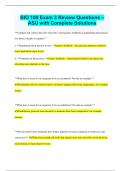
-
BIO 100 Exam 3 Review Questions – ASU with Complete Solutions
- Exam (elaborations) • 9 pages • 2024
- Available in package deal
-
- $9.99
- + learn more
BIO 100 Exam 3 Review Questions – ASU with Complete Solutions **Compare and contrast the roles of positive and negative feedback in maintaining homeostasis. Use these concepts to explain:** a. **Regulating blood glucose levels:** Negative feedback – the pancreas produces insulin to lower high blood sugar levels. b. **Formation of blood clots:** Positive feedback – initial platelets bind to the injury site, attracting more platelets to the area. **What does it mean for an organi...
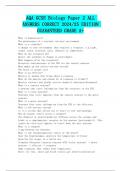
-
AQA GCSE Biology Paper 2 ALL ANSWERS CORRECT 2024/25 EDITION GUARANTEED GRADE A+
- Exam (elaborations) • 26 pages • 2024
-
- $12.49
- + learn more
What is homeostasis? The maintenance of a constant internal environment. What is a stimulus? A change in your environment than requires a response. e.g Light, sound, touch, pressure, pain, chemical or temperature. What do the receptors do? Detect the stimulus or change in environment. What happens after the receptors? Receptors send messages to the CNS via the sensory neurone. What makes up the central nervous system? The brain or spinal cord What is an effector? Muscles or glands tha...
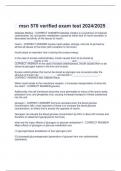
-
msn 570 verified exam test 2024/2025
- Exam (elaborations) • 84 pages • 2024
- Available in package deal
-
- $17.99
- + learn more
msn 570 verified exam test 2024/2025 Diabetes Mellitus - CORRECT ANSWER-Diabetes mellitus is a syndrome of impaired carbohydrate, fat, and protein metabolism caused by either lack of insulin secretion or decreased sensitivity of the tissues to insulin. insulin - CORRECT ANSWER-causes rapid uptake, storage, and use of glucose by almost all tissues of the body (with exception to the brain). Insulin plays an important role in storing the excess energy. In the case of excess carbohydrates...

How did he do that? By selling his study resources on Stuvia. Try it yourself! Discover all about earning on Stuvia


